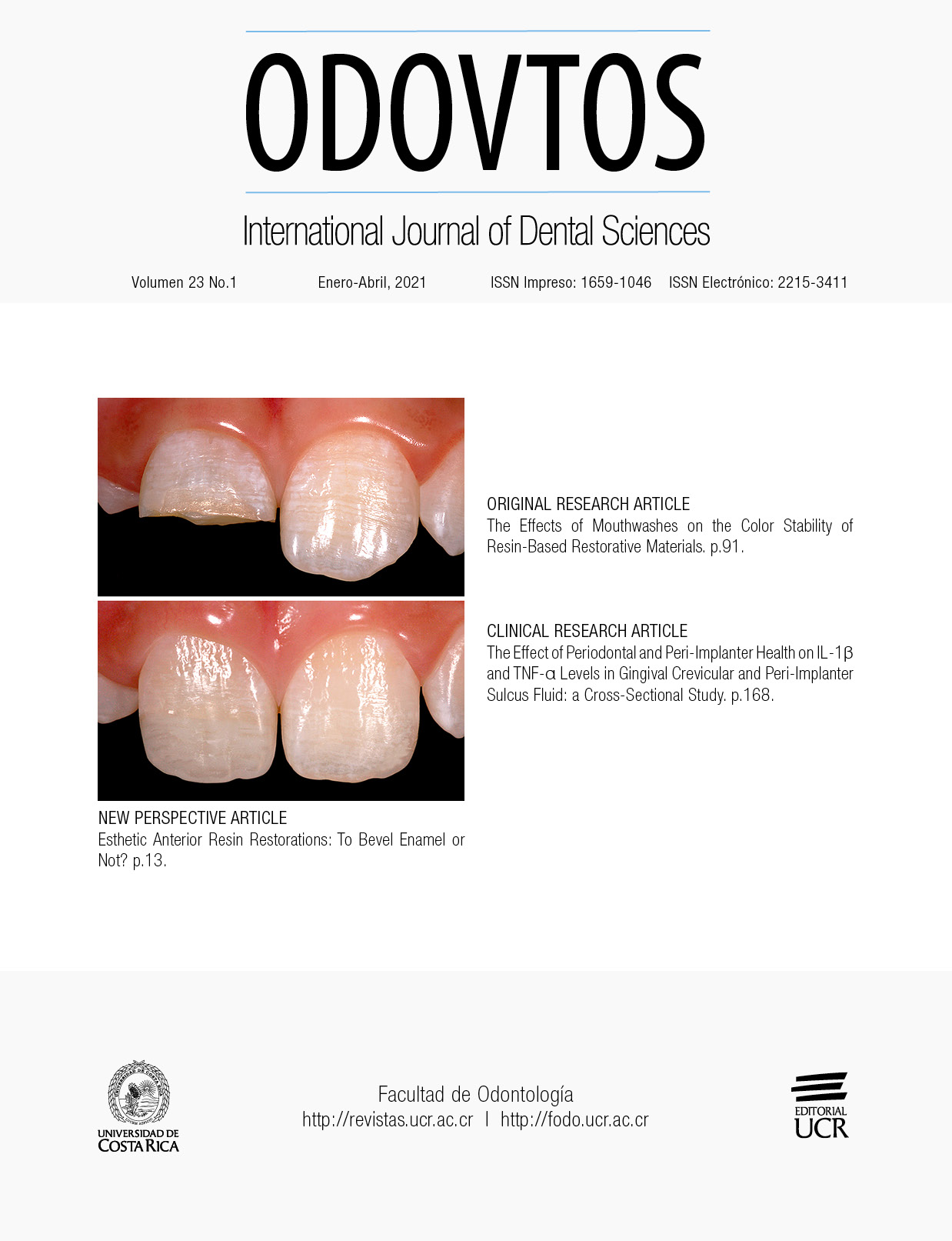Abstract
Digital impresión allows the dentist to directly obtain the data of the dental pieces that neet to be rehabilitated, giving it greater precisión and thus eliminating the impression and manufacturing of the dental model, error-sensitive aspects of the clinical phase. The aim of this review is to identify the most accurate intraoral digital impression system and identifiy the factors that affect the accuracy in the restorative dentistry. Through a bibliographic review with search in PubMed and Embase databases, 153 articles were obtained, after qualitative evaluation they were included in the revisión 14 that met the inclusion and exclusion criteria. It was determined that the experience of the dentist, the convergence in the dental preparation and the cervical termination are decisive at the accuracy of the digital impression, however, the use or not of dust is not relevant. The Lava C.O.S., iTero and True definition are the most accurate always depending on the type of rehabilitation to be performed.
References
Birnbaum N. S., Aaronson H. B. Dental impressions using 3D digital scanners: virtual becomes reality. Compend Contin Educ Dent. 2008; 29 (8): 494, 496, 498-505.
Zarauz Yáñez C., Pradíes Ramiro G., I U. C. de M. F. de O. D. de E. Estudio comparativo “in vivo” de un sistema de impresión convencional con elastómeros vs. un sistema de impresión digital (ITERO): Trabajo de investigación. 2012. España.
Brawek P. K., Wolfart S., Endres L., Kirsten A., Reich S. The clinical accuracy of single crowns exclusively fabricated by digital workflow the comparison of two systems. Clin Oral Investig. 2013;17 (9): 2119-25.
da Costa J. B., Pelogia F., Hagedorn B., Ferracane J. L. Evaluation of different methods of optical impression making on the marginal gap of onlays created with CEREC 3D. Oper Dent. 2010; 35 (3): 324-9.
Logozzo S., Zanetti E. M., Franceschini G., Kilpelä A., Mäkynen A. Recent advances in dental optics. Part I: 3D intraoral scanners for restorative dentistry. Opt Lasers Eng [Internet]. 2014; 54 (0): 203-21.
Quaas S., Rudolph H., Luthardt R. G. Direct mechanical data acquisition of dental impressions for the manufacturing of CAD/CAM restorations. J Dent. 2007; 35 (12): 903-8.
Dehurtevent M., Robberecht L., Behin P. Influence of dentist experience with scan spray systems used in direct CAD/CAM impressions. J Prosthet Dent. 2015; 113 (1): 17-21.
Miyazaki T., Hotta Y., Kunii J., Kuriyama S., Tamaki Y. A review of dental CAD/CAM: current status and future perspectives from 20 years of experience. Dent Mater J. 2009; 28 (1): 44-56.
Güth J. F., Keul C., Stimmelmayr M., Beuer F., Edelhoff D. Accuracy of digital models obtained by direct and indirect data capturing. Clin Oral Investig. 2013; 17 (4): 1201-8.
Seelbach P., Brueckel C., Wöstmann B. Accuracy of digital and conventional impression techniques and workflow. Clin Oral Investig. 2013; 17 (7): 1759-64.
Ng J., Ruse D., Wyatt C. A comparison of the marginal fit of crowns fabricated with digital and conventional methods. J Prosthet Dent. 2014; 112 (3): 555-60.
Syrek A., Reich G., Ranftl D., Klein C., Cerny B., Brodesser J. Clinical evaluation of all-ceramic crowns fabricated from intraoral digital impressions based on the principle of active wavefront sampling. J Dent. 2010; 38 (7): 553-9.
Tidehag P., Ottosson K., Sjögren G. Accuracy of Ceramic Restorations Made Using an In-office Optical Scanning Technique: An In Vitro Study. Oper Dent. 2013; 308-16.
Almeida e Silva J. S., Erdelt K., Edelhoff D., Araújo É., Stimmelmayr M., Vieira L. C. C., et al. Marginal and internal fit of four-unit zirconia fixed dental prostheses based on digital and conventional impression techniques. Clin Oral Investig. 2014; 18 (2): 515-23.
Tamim H., Skjerven H., Ekfeldt A., Rønold H. J. Clinical evaluation of CAD/CAM metal-ceramic posterior crowns fabricated from intraoral digital impressions. Int J Prosthodont. 2014;27(4):331–7.
Schaefer O, Decker M, Wittstock F, Kuepper H, Guentsch A. Impact of digital impression techniques on the adaption of ceramic partial crowns in vitro. J Dent. 2014; 42 (6): 677-83.
Svanborg P., Skjerven H., Carlsson P., Eliasson A., Karlsson S., Ortorp A. Marginal and internal fit of cobalt-chromium fixed dental prostheses generated from digital and conventional impressions. Int J Dent. 2014; 2014: 534382.
Scotti R., Cardelli P., Baldissara P., Monaco C. Clinical fitting of CAD/CAM zirconia single crowns generated from digital intraoral impressions based on active wavefront sampling. J Dent. 2011; 1-8.
Hamza T. A., Ezzat H. A., El-Hossary M. M. K., Katamish H. A. E. M., Shokry T. E., Rosenstiel S. F. Accuracy of ceramic restorations made with two CAD/CAM systems. J Prosthet Dent. 2013; 109 (2): 83-7.
Reich S., Kern T., Ritter L. Options in virtual 3D, optical-impression-based planning of dental implants. Int J Comput Dent. 2014; 17 (2): 101-13.
Boeddinghaus M., Breloer E. S., Rehmann P., Wostmann B. Accuracy of single-tooth restorations based on intraoral digital and conventional impressions in patients. Clin Oral Investig. 2015 Feb 20.
Quaas S., Loos R., Rudolph H., Luthardt R. G. Randomized controlled trial comparing direct intraoral digitization and extraoral digitization after impression taking. Int J Prosthodont. 2015; 28 (1): 30-2.
Nedelcu R. G., Persson A. S. K. Scanning accuracy and precision in 4 intraoral scanners: An in vitro comparison based on 3-dimensional analysis. J Prosthet Dent. 2014; 112 (6): 1461-71.
Medina-Sotomayor P., Pascual-Moscardó A., Camps I. Correction: Accuracy of four digital scanners according to scanning strategy in complete-arch impressions. PLoS One. 2018; 13 (12): e0209883.
Medina-Sotomayor P., Pascual-Moscardo A., Camps A. I. Accuracy of 4 digital scanning systems on prepared teeth digitally isolated from a complete dental arch. J Prosthet Dent. 2019; 121 (5): 811-20.
Medina-Sotomayor P., Pascual-Moscardo A., Camps I. Relationship between resolution and accuracy of four intraoral scanners in complete-arch impressions. J Clin Exp Dent. 2018; 10 (4): 0-0.

